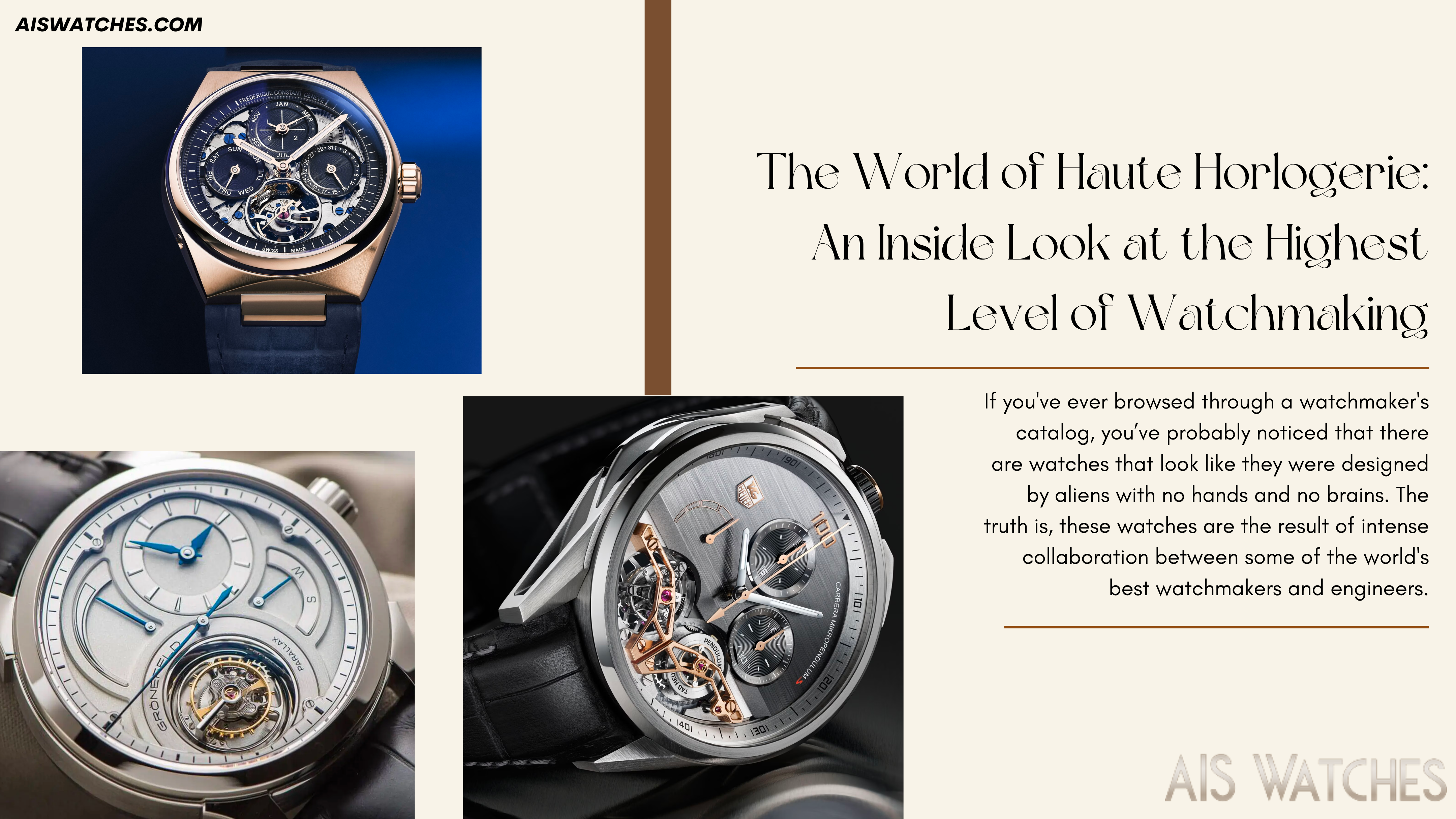The World of Haute Horlogerie: An Inside Look at the Highest Level of Watchmaking
Posted by AIS Watches on Apr 25th 2023
If you've ever browsed through a watchmaker's catalog, you’ve probably noticed that there are watches that look like they were designed by aliens with no hands and no brains. The truth is, these watches are the result of intense collaboration between some of the world's best watchmakers and engineers. They're called Haute Horlogerie or "High Horology", and their goal is to create watches that push the boundaries of what timekeeping can do. So what exactly does it take for a watch to qualify as "Haute Horlogerie"? Here's an inside look at what makes these unique pieces tick:

Fine Finishing
When you're talking about fine finishing, you're talking about the highest quality materials and methods of construction. The watch is made with the best possible materials and then polished to a mirror shine. The movement is finished to an extremely high standard (which means it has been inspected for defects). It's also hand-finished by artisans who know what they're doing--and they do it well!
The result? A watch that looks like it was plucked straight out of its owner's dreams: diamonds set into the case or band; gold accents; engravings on the dials...you name it! It might sound like overkill at first glance but there are people out there who want their watches looking exactly like this--and why shouldn't they?
Interesting, innovative and non-standard movements
The most important part of a watch is its movement, or "movement" for short. This is what makes the watch unique and therefore expensive. A great deal of thought goes into designing new movements, making them interesting and innovative in their own way.
The best-known brand in this area is Patek Philippe with their Caliber 89 movement (the most complicated mechanical watch ever made). The Caliber 89 has 27 complications including a thermometer that can measure temperature up to 1/10th of a degree Celsius accuracy!
Exotic Functions or Complications
Haute Horlogerie, or high watchmaking, is a craft that involves the creation of exceptional and complex timepieces. One of the defining features of Haute Horlogerie is its use of exotic functions and complications. These are additional features beyond the basic timekeeping function of a watch that serve to enhance its performance and appeal. Examples of exotic functions include tourbillons, which counteract the effects of gravity on the watch's accuracy, and perpetual calendars, which automatically adjust for leap years. Other complications include minute repeaters, which chime the time on demand, and chronographs, which offer stopwatch capabilities. These exotic functions require a high level of skill and expertise to create and are often found in limited edition or one-of-a-kind watches. The use of exotic functions and complications is a hallmark of Haute Horlogerie and adds to the allure and prestige of these exceptional timepieces.
Technical Innovation
When you think of a timepiece, you probably picture something that tells the time. But in haute horlogerie, the movement--the mechanism that makes it work--is more than just a means to an end. It's an expression of artistry and creativity, incorporating elements like design and engineering into one cohesive unit.
The movement is like the soul of your watch: it houses all its vital organs (i.e., gears). It's what gives it life; without it, your watch would be nothing more than an empty shell with no purpose other than to look pretty on your wrist or dresser top (and maybe tell you how long until lunch). Without these tiny yet powerful components inside each individual watch case, there would be no way for them to function properly--or even exist at all!
Interesting and Expensive Decoration
In addition to the traditional materials used in watchmaking, there are several other materials that are sometimes used for decoration. These are often very expensive and hard-to-find elements that make the watch even more exclusive. The most common of these include:
Gold and platinum - The use of precious metals has been a hallmark of luxury watches since their inception. While gold is considered by many people to be an outdated material, it still makes up 80% of all jewelry sold worldwide every year (and many watches as well). Platinum is also popular because it's so durable--it doesn't oxidize like silver does over time, meaning your watch will stay looking good longer than other types would! Both metals can be used routinely without affecting their value; however if you want something truly unique then consider using meteorite (the remains from space collisions)!
Interesting and Unusual Materials
High horology watches are expensive because of the materials used. When you buy a high horology watch, you're paying for more than just the mechanical movement and case; you're also investing in rare or unique materials that make each piece unique. Some examples include:
- Gold, platinum, diamonds and other precious stones (e.g., ruby or sapphire)
- Unique or custom alloys made by a particular manufacturer (e.g., Rolex's Oystersteel)
High Horology is the pinnacle of watchmaking, but it appeals to a very small subset of people.
High Horology is the pinnacle of watchmaking, but it appeals to a very small subset of people. High Horology is for people who are interested in the technical aspects of watches, and who want to see what is possible with the most advanced technology and materials.
The rest of us are perfectly happy with our sub-$10k timepieces (or even our inexpensive quartz ones). If you're not one of those people though--if you have enough money and desire--there are plenty of opportunities out there for you!
In the end, high horology is a very small part of the watchmaking world. It appeals to only a subset of people and has limited appeal outside of that group. Most people are not going to spend thousands on a watch unless it has some sort of sentimental value or is just plain cool looking.
 Menu
Menu




